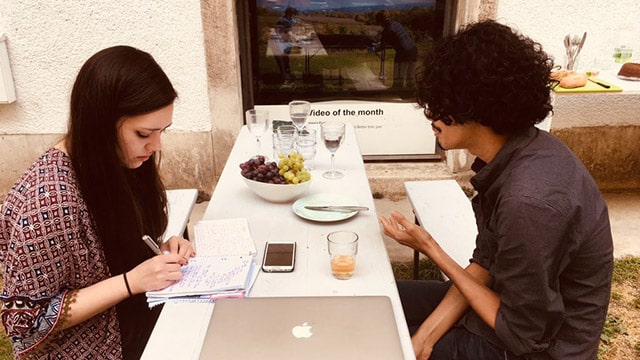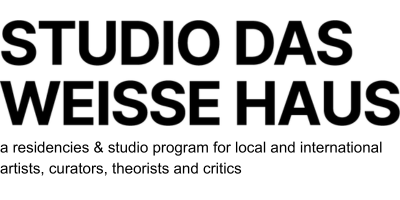Weekly Conversations... with Poklong Anading

This week we are talking to Poklong Anading about his beginning residency in Vienna and his plans for his upcoming exhibition at das weisse haus.
Regarding your work and also yourself, do you have any expectations of your residency at studio das weisse haus in Vienna? My concept for the residency is exploring the duration of my stay here in itself. I am thinking of a system, a cycle or a process of doing a project for a certain period of time. I am thinking of what I could possible learn and contribute while I’m here. I think it’s more important what I can experience here, rather what I am going to “make”. I’m thinking that it’s pointless to make something that I could actually make at my own studio back home. What I cannot do there is to feel myself being here and explore the city of Vienna. I consider the experience will be the work in itself. This is how I want to look at it. What kinds of connection will I’m going to have in this specific place? What is the essence of a residency? What is the connection of this place and the people navigating within to what I’m about to experience here? Art residencies are forms of hosting. What fascinate me are the invisible hosts. One example is the sewer system. This being covered by concrete and city planning, hosting secretions. I’m curious how secreted matters circulate underground in a sewerage system. How does a sewage system process them, before transforming and returning them back into the vast body of water? As with the camera is a host too. It takes in light that produce a picture. Using works from past and on-‐going residencies, my attempt is to follow and observe the paths of water, such as rivers and canals. I like to investigate around the undulating flow of water within the urban and rural landscape. Look for the various channels that connect the daily activity of the people within an area. The captured lights could traverse and evolve around the exhibition space that will continually explore the possibilities of engagement within my immersion period. Producing something is a secondary thing. It’s the basis of that search and perception. The things that will inspire me from this exploration will be the traces of my experience. I want to find some kind of connection to the exhibition space and to what’s going on outside.
Since you have already exhibited several times in Graz, what is your impression of the Austrian art scene or cultural landscape? It’s so hard to give my impression. I didn’t have enough time to immerse myself with the artscene. Most of the time when you are given a slot for an exhibition, you’re so occupied dealing with all these problems setting up for the exhibition. But I have met wonderful artist friends here. Artists that I have met from previous stays, which open, up my mind on their unique thoughts of thinking. It’s a quite a busy scene. Many things are going on and it’s impossible to see everything. I was introduced to Naschmarkt by Yoshinori Niwa, an artist friend from Japan who is now base here in Vienna. I find Naschmarkt as a good source of material for art projects. It somehow makes sense to the idea that I am trying to develop for the residency: All these things that we consume, we digest goes to certain flow of system. Which also brings me to the concept of recycling. How things end up in a second hand shop? How people reutilize it before the leftovers being pushed to the damn trucks. Seeing these kinds of thing is very interesting to me when you like to tackle about the art scene. Where are the possible sources for the artists to find their materials in making works? What happens to the objects that we created afterwards, where does it end up?
It’s interesting to see how people move around and respond to this unique situation of a shared space. What are the objects that would be interesting to others? What are the things to be rescued and bring to they’re own spaces that they could still use? I also want to spend more time to visit different museums, art spaces, meet new artists and get to know what they’re also doing. I’ll see what would fit with my time.
You often use objects for your works, which can be found in your immediate surroundings. Since you’ve been in Vienna for almost a week, did you have the chance to explore some places and to find something which might be useful for your project? I have been also asked before what would resonate with the trapo in other places, which I used in previous projects in Manila. I haven’t seen this so far as side in Bangkok. Trapo is a hand size circular rag use for cleaning that is made up from waste materials coming from textile industries. These are hand size made with the aid of sewing machine that’s run by relatively modest small business families. After being used for cleaning, I can spot a lot of these lying on the streets. It’s contradictory. After it was used for cleaning it also became mess in itself. I don’t want to blame, nor do I want to judge that kind of occurrences in our place but this is what persistently caught my attention. It’s like living in a city showing how people are being consumed by their own work and time. Life seems getting faster and faster. It is like loosing attention on how to handle the basic implements for cleaning. But right now my idea is not directly connected to the concept of trapo. Vienna is very clean in comparison to where I came from. But then clean is also subjective and relative. What is clean or how someone measures cleanliness? When I was on Naschmarkt, I was going around and looking for things, which I could use for my project. I am surprised from what I saw. How much object does individual is keeping. For how long can someone hold to objects? I become interested in objects that people do not need anymore and sell it on the flea market. Different shapes of mirrors caught my attention. How many faces have looked in to these mirrors. I am thinking to incorporate it and combine the idea from the name of das weisse haus. How many people have come to visit the space. Weiß or white also resonates the idea of the light, the sum of all colors. I’d like to use these mirrors as some sort of channels from the outside redirecting the light inside the gallery space. I am thinking of interacting with people on the street. Engage myself with them and see the different point of views. I like the idea from random people outside the space who will be the source of inspiration. I like to observe what would be their responses. Shedding light into the exhibition room by asking them to reflect the light coming from the sun using a mirror. I also want to explore the concept of the circulation of water, which is also resonates the idea of reflection. The Danube and its surroundings is a fascinating place for me. How people are conscious to take care of the place. I want to explore how people enjoy it and share it with one another. As well as how it’s being sustain, develop and change through time. I am curious about these things. These are some possible ideas that may change and evolve as I immerse myself in this city.
Interviewer for studio das weisse haus: Helena Lang
